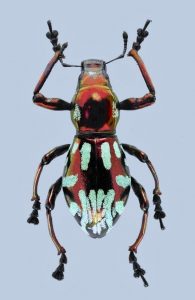
THE researchers of the University of Mindanao ‘s Coleoptera Research Center (CRC) rounded off 2021 with 21 newly discovered endemic beetle species, a record number since the center began operations in 2016. In total, the center has discovered nearly 50 new species and subspecies to science.
“It is quite a big leap considering we only described 2 new species when we started. As our team grew and collaborators expanded, with our areas of expedition going beyond the borders of the region, the discoveries also rose significantly, ” said CRC Director Dr. Analyn Cabras.
Cabras, who chosen as on of the top 15 cohorts of early-career scientists of the National Geographic Society for 2020-2021, is joined by a team of researchers composed of Chrestine Torrejos, Leslae Mantilla, Mark John Pepito, Jessa and Dexter Patalita, Efhrain Loidge Pajota, Harlene Ramillano, and Dr. Milton Norman Medina.
“Some of our notable discoveries include a relatively big longhorn beetle, 𝐶𝑒𝑟𝑒𝑜𝑝𝑠𝑖𝑢𝑠 𝑒𝑟𝑎𝑠𝑚𝑢𝑠, named after “Erasmus”, the program responsible for the education, training, and international linkages of the staff at the CRC. Another is a tiny tiger beetle, 𝑇ℎ𝑒𝑟𝑎𝑡𝑒𝑠 ℎ𝑢𝑏𝑒𝑟𝑡𝑢𝑠𝑖, named after Dr. Hubertus, who made a significant contribution to the conservation of the ancestral land of the Obu Manuvu people in Davao City, and lastly, the most colorful one is 𝑃𝑎𝑐ℎ𝑦𝑟ℎ𝑦𝑛𝑐ℎ𝑢𝑠 𝑜𝑏𝑢𝑚𝑎𝑛𝑢𝑣𝑢 – the species has the namesake of the Obu Manuvu people and has colors that resemble the colors of the tribe’s traditional garments, ” Cabras revealed.
Another new species named in 2021 is 𝑀𝑒𝑡𝑎𝑝𝑜𝑐𝑦𝑟𝑡𝑢𝑠 𝑢𝑚, a tribute to the University of Mindanao, which dons a maroon-like hue, the university’s color symbol.
In search for new beetle species, the CRC research team goes through painstaking expeditions from green spaces in urban areas to Mindanao’s expansive wilderness.
“With the help of the communities and local guides, we often stay in the field for 3 to 5 days, sometimes even longer. We employ various sampling techniques to collect different beetles from different families,” shared Torrejos.
Specimens are then taken to the laboratory for in depth examination and confirmation with the help of their colleagues and experts who help in the establishment of a species being new to science.
Asked what the discovery of the new species mean to the CRC, Mantilla replied, “it means advancement in the knowledge of Philippine coleopterology and the strengthening of the conservation efforts of our very own beetle species”.
However, 2021’s discoveries are just the beginning for this relatively young, university-based research center. “There’s more work needs to be done. We are still far from the tip of the iceberg,” Mantilla added.
The team will continue to look forward to more expeditions and activities that will help push forward beetle studies in Mindanao and the Philippines.
“We aim to for more meaningful collaborations that will support our race against time in terms of having these species documented before it’s too late. Discovery of new species comes as a bonus for us and a confirmation that there is more out species out there waiting to be discovered,” Torrejos explained.
